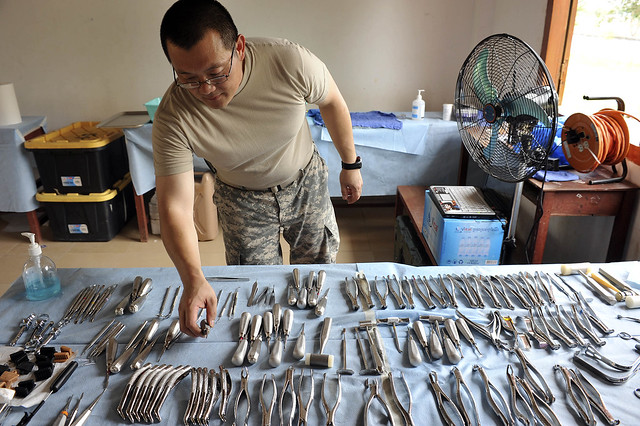An interesting article titled “Dental anxiety in relation to torture experiences and symptoms of posttraumatic stress disorder,” written by Høyvik et al. appears in the European Journal of Oral Sciences (vol. 127, pp. 65-71, 2019). The article sought to explore dental anxiety amongst those who have suffered torture experiences and have experienced symptoms of post-traumatic stress disorder (PTSD).
The article describes how in recent years Europe has received an increase in refugees and asylum seekers from countries experiencing war. As a group these refugees and asylum seekers have a high amount of mental health issues which could be due to experiencing stressful events in their life such as torture. The authors state:
“Several aspects of the dental visit resemble the torture situation. The patients may feel tied to the dental chair and are literally underneath health personnel in white coats administering sharp, metallic instruments with strong resemblances to torture devices. Bright light directed towards the face may reactivate memories of the interrogations and provoke loss of control, and victims of water torture may react strongly to exposure to water in the oral cavity.”
The authors say that PTSD symptoms correlate positively with torture with the primary symptoms being negative thoughts and feelings, increased arousal and reactive symptoms, avoidance behavior and reliving the trauma through flashbacks and nightmares.
For the study the authors recruited refugees and asylum seekers in Norway. A total of 173 refugees took part in the study all over the age of 18. The majority were from Eritrea, Syria, and Somalia. For the study an oral examination occurred along with verbally administered questionnaires through the use of interpreters. The study collected basic sociodemographic variables such as age, gender, and education level. They were also asked about their past dental visits. The study assessed torture experience using the trauma section of the Harvard Trauma Questionnaire Revised Part 4 and were asked direct questions regarding past torture experiences. Dental anxiety was assessed using a Modified Dental Anxiety Scale with a score of 15 or higher indicating dental anxiety.
Of the participants 47% (81 of 173) had been exposed to torture. Among the participants reporting torture, 53.1% showed symptoms of PTSD. In those who survived torture survivors, 62% had experienced torture against their face, 35% experienced torture against their mouth, and 23% experienced torture against their teeth. It was found that in refugees with dental treatment-experience after arriving in Norway, the median Modified Dental Anxiety Scale score was 11 in torture survivors compared with 7 in other refugees. It was also found that the odds of being highly dentally anxious were 6.1 times higher in refugees with torture experience and 9.3 times higher in torture victims with PTSD symptoms after accounting for age, gender, education, and dental treatment need.

Thus the authors found that torture victims are more prone to dental anxiety. Furthermore, dental anxiety is more prevalent in refugees suffering from PTSD. Thus the authors feel that a torture survivor with PTSD symptoms will be more susceptible to triggers during a dental treatment situation and be more likely to develop dental anxiety. The authors do point out that the median Modified Dental Anxiety Scale score in torture survivors was not significantly higher than in other refugees. Some of this could have been due to only a third of the individuals visiting a dentist after experiencing torture. Further, many of the patients were in high need of dental treatment and the perceived need could have outweighed the dental anxiety.
The authors later state
“Torture survivors report a significantly larger number of symptoms of PTSD, and dental anxiety shows a higher prevalence in refugees suffering from PTSD symptoms than in refugees who do not. Oral health professionals should be aware of this and be attentive when they meet refugee patients with evident dental anxiety.”
Thus the authors feel that dentists may have an obligation to further refer those refugees they are treating for further mental and physical health care if they feel it may be warranted. They also must be mindful of potential re-traumatization which could be in particular for those who received torture involving the mouth or teeth. Even so the authors were not able to determine statistically whether those who received torture involving the mouth or teeth were more dentally anxious than other torture survivors due to a lack of sufficient sample size.
